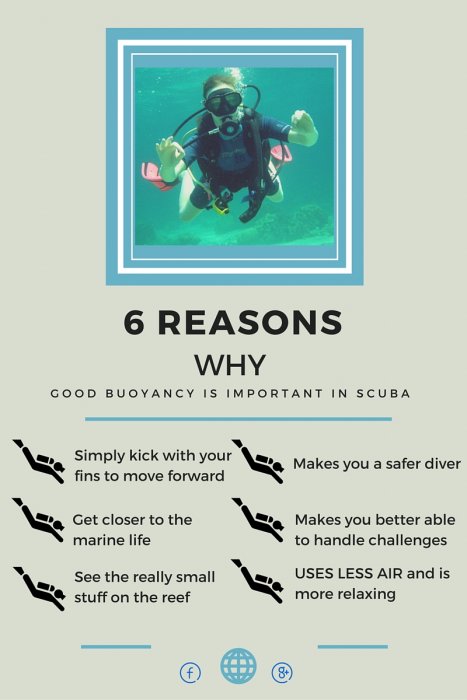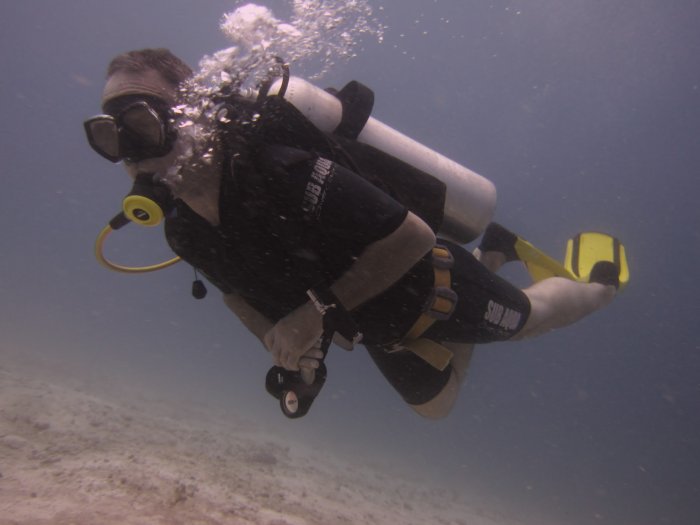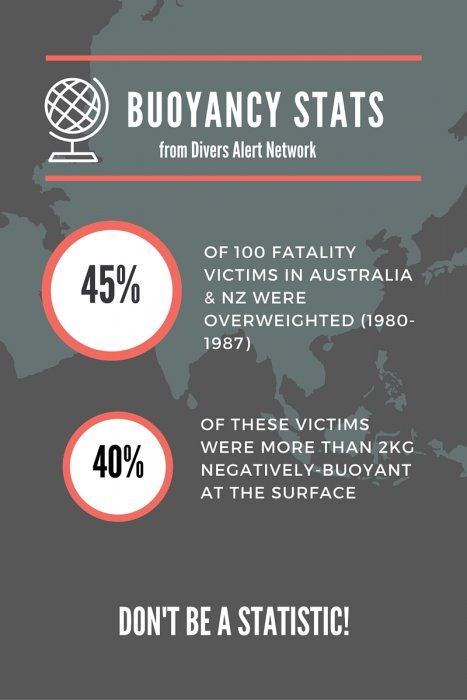Buoyancy Basics Part 1: Why is Buoyancy important?
2017-02-01 12:14:46

6 reasons buoyancy is important scuba diving
Very often a diver will come up after a dive and ask us: Why was this dive so tiring? Or even more often: Why did I use up my air so fast?
More often than not, the answer has to do with the diver not having kept a
neutral buoyancy throughout the dive. Upon hearing this, many divers are surprised to learn how strongly related
good buoyancy is to better air consumption and general well-being underwater.
Technically it
is possible to dive without ever keeping proper neutral buoyancy, which is why many people never really master this skill. Many divers spend all of their time underwater being somewhat
negatively buoyant, often without even realizing it. They do “dive”, if by
diving you mean sinking down, swimming around, and then coming back up to the surface. But they will be tiring themselves a lot more than necessary, using up their air a lot faster, and more often than not, damaging their environment by constantly bumping against the reef.
Although in this article we talk about lack of good buoyancy in general, meaning both too positive and too negative, divers are affected far more often by the latter. Too much negative buoyancy can be a bad habit divers acquire during their first dives, and never get rid of. If one has never really learned what
diving with neutral buoyancy should feel like, it's hard to even realize that there's a problem in the first place. This results in divers with dozens, sometimes even hundreds of dives still struggling with buoyancy, and not even knowing that something is not right.
It's absolutely normal for
beginner divers to have less than
perfect buoyancy underwater: you can't expect to finish your
Open Water Diver Course with a master's degree in buoyancy. But what's important is to keep working on it and keep improving; if you don't, then you will never reach your full potential as a
diver.
Here is a quick summary of why
neutral buoyancy is so important:
Divers who have too much NEGATIVE buoyancy during a dive:
- Will often find themselves deeper than the other divers in their group, or deeper than their planned maximum depth. This is because the negative
buoyancy will constantly be pulling them down, making it difficult to maintain a constant depth. you think you are swimming straight ahead, but in reality you go a bit deeper every time.
- Will often be "bouncing" off the reef, pushing themselves away with hands or fins, or lifting clouds of sand. Needless to say this is very damaging to the reef, and can also cause injuries to the diver. Plus it looks horrible! Not even the fish will want to get close to you.
- Will have a hard time getting close to look at something small, like a nudibranch or scorpion fish, because if they get in a horizontal or slightly head-down position, they will immediately sink and crash into the reef or into whatever they are trying to look at. You definitely don't want to do that with a scorpion fish, right?
- Will find it difficult to dive at a slow, leisurely pace. This is because in order to compensate for the negative
buoyancy, they will need to be constantly finning to stop themselves from sinking. And of course if you are constantly kicking, you are constantly moving forward as well. So you will always be ahead of your group, and miss out on that cool mantis shrimp the dive master was showing everyone else. Not to mention the safety hazard of getting separated from your buddy!
- Will probably get more tired. This has also to do with the non-stop kicking. If you have to be in constant movement just to stay in one place and not sink, your muscles will definitely feel the strain!
- Will find it very hard to swim against even the smallest current, because their body position is not completely horizontal, creating a lot more drag and resistance.
- Last and probably most interesting, divers with negative buoyancy will probably use their air a lot faster than they could. This again has to do with the constant kicking: your muscles need to exert a big effort to overcome the resistance of the water, so every movement underwater increases your breathing rhythm. If you are kicking all the time to stop yourself from sinking, then you will be breathing a lot harder and using up your air a lot faster.
Divers with too much POSITIVE buoyancy during a dive:
- Will often find themselves in a head-down, feet up position, kicking downwards, and breathing hard. It will feel like you are fighting a current, even when there is none!
- Will often miss their safety stop. If a diver already has too much buoyancy at the diving depth, the moment they head up towards the surface this buoyancy will increase even further, dragging them up faster than the safe ascent speed; and they might not even be able to stop themselves when they reach the depth of the planned safety stop.
- Just like with negative buoyancy, they will also find it hard to relax, move and breathe slowly.
Divers with a good, NEUTRAL BUOYANCY during a dive, on the other hand...:
- Will only need to kick with their fins when they want to move forward. All the rest of the time, they can be perfectly still in the water, hovering over the reef without touching it.
- Can get much closer to marine life without scaring it away. With
neutral buoyancy, fish tend to be less frightened of you, because you are not a big scary mess of bubbles and flailing limbs. They might allow you to get much closer, and get a real good look! That includes manta rays and sharks in
Maldives or turtles in
Thailand.
- Can also look at really small stuff, because they can get as close as they want to the reef, without crashing into it.
- Are safer, because if something unforeseen happens under water, they will have only one problem to deal with, not two.
- Can handle much more challenging conditions safely, which means that they will have a wider range of dive sites they can visit. In
Maldives, for example, more current means more fish, and some of the most spectacular dive sites are also the ones where there is most current. Dive masters will only take to these dive sites divers who they know can handle the conditions.
- Will be much more relaxed, and therefore will probably use up much less air. Slower air consumption equals more time under water, which equals more fish and more fun!
Beginner divers will often have some trouble with buoyancy, which is absolutely normal, and part of the learning curve. Then, too often, once they have done a few successful dives, they will stop practicing, and stop improving.
Considering all of the above, you know that
good buoyancy is the single most important skill for a diver to master. It doesn't matter if you have 5 dives under your weight belt or 500: you can always practice and strive to improve your skills. As you have seen, the benefits are really worth it!
In our next articles of the Buoyancy series, we will talk about how to determine whether you have neutral buoyancy, and what to do to correct it if not. So STAY TUNED.
At
SUB AQUA DiveCenters we strive to offer the best possible service to our divers, and that includes helping them to improve their buoyancy, if they wish. So come diving with us, and don't be shy: ask questions, ask for help and advice!
Our instructors will be happy to assist you. Or take a Peak Performance Buoyancy specialty course, if you really want some practice time with an instructor.
PADI courses at SUB AQUA DiveCenters.
Continue to Part 2 - Understanding Buoyancy: Positive or Negative?

Diver with neutral buoyancy



 Buoyancy statistics from Divers Alert Network
Buoyancy statistics from Divers Alert Network Diver with neutral buoyancy
Diver with neutral buoyancy